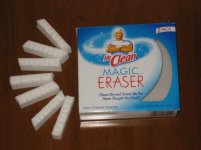I know this subject has been beat to death, but I have a couple specific questions if someone can help me.
First off, I am not going to use alcohol, water, wax, low grit sand paper (below 2500 grit) on my shaft because it does not get that dirty. I keep it wiped down and I have very dry hands. I'm looking for information on minor conditioning. Here are my questions:
1. Does anyone know the grit number of Magic eraser pads? It feels like 2000 but I'm not sure. The dry form of Magic eraser could answer my question but I'm concerned how the shaft will feel after I use it.
2. What alternate source is the equilavant of 4000 grit sand paper? Paper bag maybe? 4000 grit should get the light stuff off, but I cannot find any.
3. Last one....after using something (above maybe), which of the following would make it the slickest? paper bag, micro mesh wrag of some kind, dollar bill or leave it alone after the 4000 grit and/or magic eraser?
Thanks in advance........and I know that wax and other methods are probably better but my shafts are all in good shape and I do not want to change them.
thanks, jed
First off, I am not going to use alcohol, water, wax, low grit sand paper (below 2500 grit) on my shaft because it does not get that dirty. I keep it wiped down and I have very dry hands. I'm looking for information on minor conditioning. Here are my questions:
1. Does anyone know the grit number of Magic eraser pads? It feels like 2000 but I'm not sure. The dry form of Magic eraser could answer my question but I'm concerned how the shaft will feel after I use it.
2. What alternate source is the equilavant of 4000 grit sand paper? Paper bag maybe? 4000 grit should get the light stuff off, but I cannot find any.
3. Last one....after using something (above maybe), which of the following would make it the slickest? paper bag, micro mesh wrag of some kind, dollar bill or leave it alone after the 4000 grit and/or magic eraser?
Thanks in advance........and I know that wax and other methods are probably better but my shafts are all in good shape and I do not want to change them.
thanks, jed
Last edited:
